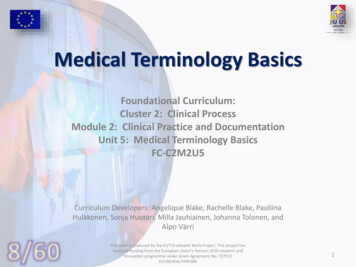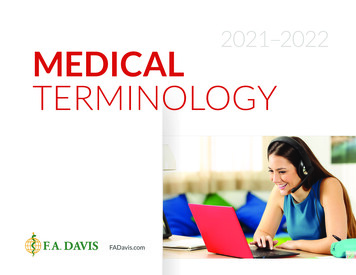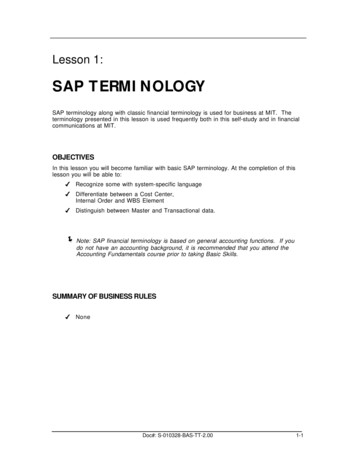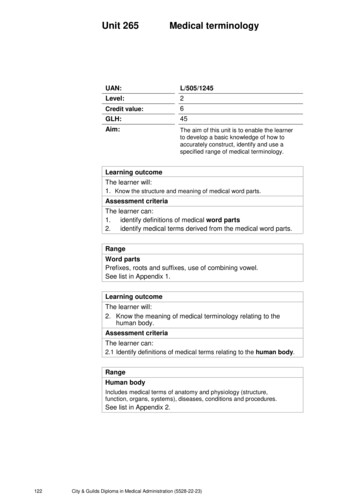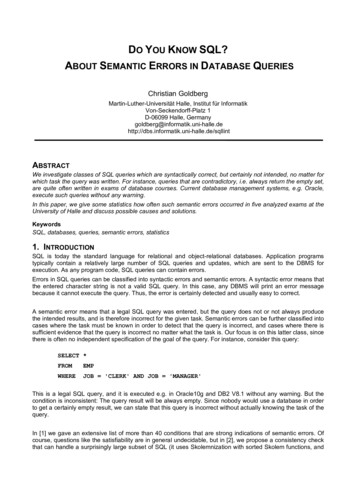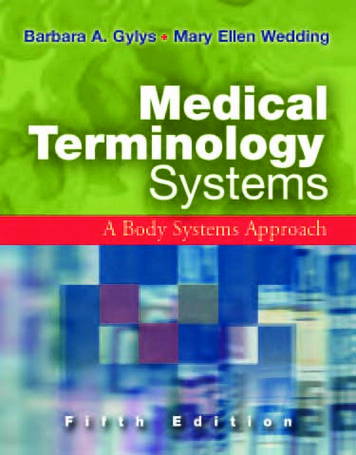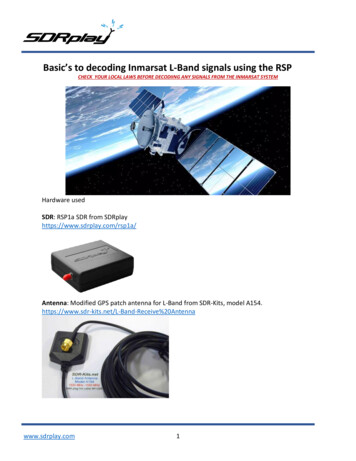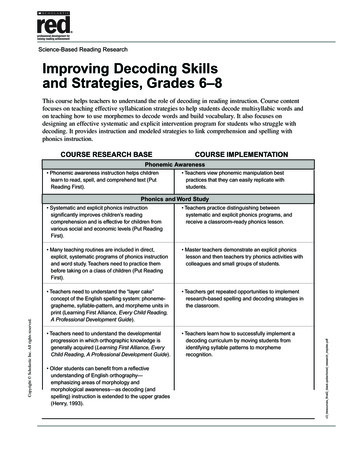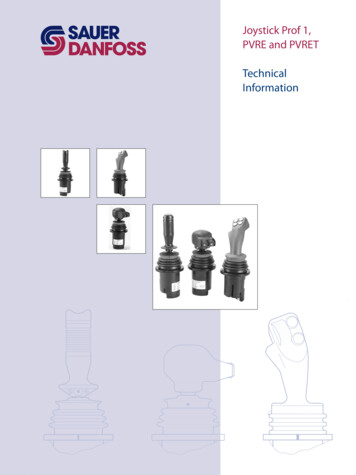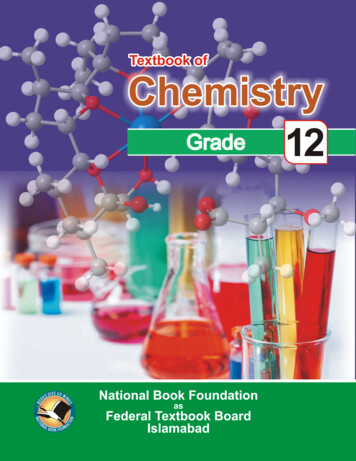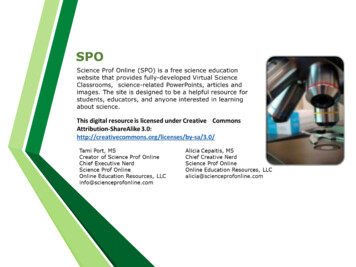
Transcription
Decoding Medical TerminologyFrom the Virtual Anatomy and Physiology Classroom on ScienceProfOnline.com
Why do we need so many terms? The study of anatomy and physiology may seem much like learning a new language. Itis, in fact, learning pieces of old languages put together to create new meaning. Thislecture will provide some pointers on how to go about learning these pieces and parts.From the Virtual Anatomy and Physiology Classroom on ScienceProfOnline.com
Jargon of the tradeAre all the new cover sheetson the TPS reports?It appears that thepatient has a subduralhematoma in the righttemporal lobe.You need get me ablind count on thatbreak-bulk shipment. Any profession practiced today uses jargon to provide quickand meaningful communication. Whether you are a nursein the emergency room, a family doctor in the office, or apatient awaiting test results, being able to communicateclearly and effectively is extremely important.From the Virtual Anatomy and Physiology Classroom on ScienceProfOnline.com
Precise and efficient communication Medical terminology is an agreed upon set of words thathelp explain body parts, body processes, diseases,procedures and diagnoses. Most medical terminology is based in Latin or ancient Greek.These languages are used as the basis for medicalterminology because they are no longer used in moderneveryday language. This lends stability in the way theterminology is used because the meanings of the words nolonger change radically as with commonly used words. This agreed upon system of naming helps speed up writtenand verbal communication as well as helping to reducemistakes due to misunderstanding.From the Virtual Anatomy and Physiology Classroom on ScienceProfOnline.com
Hippocrates and Aristotle These two ancient Greekphilosophers had a largeimpact on the teaching andtraining of physicians forcenturies. Over 2,000 years agoHippocrates and Aristotlesaw the need for specific,descriptive medicalterminology that could beused widely in training newphysicians.The physician heals, nature makes well. AristoleThe art of medicine consists of three elements: thedisease, the patient, and the doctor. HippocratesFrom the Virtual Anatomy and Physiology Classroom on ScienceProfOnline.com Even though many of theirideas about human healthproved false (ie. 4 bodilyhumors that must bebalanced) the standardsthey brought to speakingand writing about medicinehave been maintainedthroughout the centuries.
Etymology Etymology, not to be confused with thestudy of insects, is the study of the originsof words shown by tracing theirdevelopment and linguistic relationships. For example, the English adjective medicalderives from the 1600s French term médicalmeaning healer which derives from theLatin medicus which means physician orsurgeon. Dissection of words is as important tolearning anatomy as the dissection oforgans. If you know the meaning of aselection of prefixes, roots and suffixes youcan piece together the meaning of mostmedical terminology.From the Virtual Anatomy and Physiology Classroom on ScienceProfOnline.comComic from maydaycomic.wordpress.com
RootsCommon Examples: In any medical term there is a root,or the main part of the word. Someterms can even have more than oneroot. The root of a medical term containsthe essential meaning of the wordand most often refers to a body partor nLinguTongueFrom the Virtual Anatomy and Physiology Classroom on ScienceProfOnline.com
PrefixesCommon Examples:PrefixMeaning Many medical terms also have aprefix in front of the root.A-Without; absence ofAna-Up; again; backward The prefix is a modifier of the rootand usually refers to how, why,when, where how much, how manyposition, direction, time or status.Brady-SlowCata-DownDia-ThroughEcto-Outer; outsideEso-InwardEpi-On; overHyper-Above; excessiveHypo-Below; deficientInfra-Under; belowMal-BadMeso-MiddleMeta-After; changeOsteo-BonePeri-SurroundingNeo-NewSyn-Joined; togetherTachy-Fast; rapidFrom the Virtual Anatomy and Physiology Classroom on ScienceProfOnline.com
SuffixesCommon Examples: A suffix is a modifier of the rootlocated after the root. Suffixes will most often indicate aprocedure, condition or disease. not all medical terms will have asuffix.SuffixMeaning-algiaPain-celeProtrusion, hernia-clastBreak-critTo separate-cyteCell-ectomySurgical removal-emesisVomiting-emiaBlood condition-genicProducing; causing-iaAbnormal state-itisIinflammation-lysisLoosening; separating-omaTumor; swelling-otomyCut into; incision-porosisPassage-sepsisInfection-sisState of-trophyNourishment-uleLlittleFrom the Virtual Anatomy and Physiology Classroom on ScienceProfOnline.com
Putting it all together Linking or combining vowels are often added to medical terms tojoin roots, prefixes or suffixes. Sternoclaidomastoid is an example of a term that uses three rootsand no prefix or suffix but requires two linking vowels. Thesternocleidomastoid is a muscle that has an attachment or originon three different bones:RootMeaningSternSternum (breast bone) 1ClaidClavicle (collar bone) 2MastoidMastoid process(skull temporal bone protrusion) 3Stern-O-Claid-O-MastoidFrom the Virtual Anatomy and Physiology Classroom on ScienceProfOnline.com321
ExamplesHeadache cephalgiaceph head; algia painrootsuffixSlow heartrate bradycardiabrady slow; cardia heartprefixrootRheumatism osteoarthritisosteo bone; arthr joint; itis inflammationprefixrootsuffixFrom the Virtual Anatomy and Physiology Classroom on ScienceProfOnline.com
EponymsJohann Gottfried Zinn 1727-1759Zonule of Zinn:(my personal favorite eponym)This is the structure in the eyethat connects thelens to the iris.F.G.J. Henle 1809-1885Loop of Henle:This is a structure in the nephronof a kidney that helps controlwater balance.Louis-Antoine Ranvier 1835-1922Node of Ranvier:This is gap between the pillows ofmyelin on a particular part of aneuron.Medical eponyms do not follow the prefix, root, suffix pattern. These medical terms are usually derivedfrom the name of the researcher who discovered the condition or described the anatomical structure first.While there is a trend toward changing some eponyms to more descriptive Greek and Latin based terms thereare still plenty of eponyms in use today. In current usage the possessive apostrophe is not required.Unfortunately, these terms must be memorized or looked up in reference rather that “dissection” the term tofind its meaning.From the Virtual Anatomy and Physiology Classroom on ScienceProfOnline.com
Practice ExerciseUse the prefix, root, and suffix reference guide from Wikipedia and the FreeMedical Dictionary to determine the meaning of the terms below. The definitionfor each word is either a condition, a procedure or referring to an ist of medical roots, suffixes and y.com/1. achromatopsia2. bronchoalveolar3. cephalocele4. districhiasis5. embolectomy6. fibrosarcoma7. gastroduodenal8. hematomyelia9. dilationWernicke’s encephalopathyxanthocytezoonosisFrom the Virtual Anatomy and Physiology Classroom on ScienceProfOnline.com
Practice Exercise Answers 1-8TermPrefix; Root; SuffixBrief Definition: Term Typeachromatopsiawithout; color;visionColorblindness; conditionbronchoalveolarwindpipe; air sac;adjective formreferring to the junction of the windpipeand the alveoli in the lungs; structurecephalocelehead; protrusioncerebral hernia; conditiondistrichiasistwo; hair; formationtwo hairs growing from the same follicle;processembolectomyblood clot; removalsurgical removal of a blood clot within avessel; procedurefibrosarcomahairlike; tumor ofconnective tissuemalignant tumor of fibrous lating torelating to the junction of the stomachand 1st segment of the small intestine;structurehematomyeliablood; spinal cord;conditionappearance of blood in the spinal cordFrom the Virtual Anatomy and Physiology Classroom on ScienceProfOnline.com
Practice Exercise Answers 9-16TermTermPrefix;Root;Term TypePrefix;Root; Suffix Brief Definition;Brief DefinitionSuffixinfrascapularachromatopsiabelow; shoulderblade; adjectiverelating to the area under the shoulderblade; adjective form of namebronchoalveolarjejunectomy2nd intestinalsection; removalofthe surgical removal the 2nd section ofthe small intestines; proceduremotion; conditionmotion sickness, sea sickness;conditionlips; teeth;pertaining toabout the lips and teeth; regionone; nerve;inflammationinflammation of a single nerve;conditionnerve; formation;formation of nervous tissue; processovary; tube;inflammationinflammation of the ovary and oviduct;conditionmay; nerve;concerningreferring to many ionicFrom the Virtual Anatomy and Physiology Classroom on ScienceProfOnline.com
Practice Exercise Answers 17-24Prefix; Root;SuffixBrief Definition;Brief DefinitionTerm Typeretinoblastomaretina; spinalblood;embryoniccord;cellcancer;conditiona genetically caused malignant tumor inthe eyescapuloclavicularscapula; clavical;pertaining toconcerning the region surrounding thescapula and clavicle; adjectivethrombocystclot; saca membrane sac covering a blood cloturanoplastyhard palate;repaira surgical operation to repair a cleftpalate; procedurevasodilationblood vessel;increase indiameter;the increase in internal diameter of ablood vesselWernicke’sencephalopathyproper name;brain; diseasea hemorrhagic form of degenerativebrain disease described by CarlWernickexenograftforiegn; livingtissue transplant;surgical transplant of tissue from ananimal to a personzoonosisanimal; disease;transmission of a disease from ananimal to a person; processTermFrom the Virtual Anatomy and Physiology Classroom on ScienceProfOnline.com
Recall techniquesPractice is key to learning any new language. Below you will find a list of methods forpracticing anatomy and physiology terminology.1. Mnemonic devices: These are simple ways to memorize lists of terms. Devise anacronym or phrase to practice the order of terms.cranial bones (skull): “Old Pygmies From Thailand Eat Skulls.”Occipital; Parietal; Frontal; Temporal; Ethmoid: Sphenoid2. Word grouping and color coding: Sometimes it’s easier to remember terms based ontheir relationship to other terms. Writing related terms in lists or on cards in the samecolor and using them to review can help to recall the term later.Grouping ideas: system, function, condition, procedure, body part.3.Matching: this is a handy way to connect terms with their definitions. For each termuse two cards, one for the term and one for the definition. on the other side of eachdraw the same small symbol (smiley face, star, square and so on). Place the groups ofcards on a table and time yourself while you are matching the definition to the termusing the symbol to check that you are correct. Race yourself or a partner to see howyour recall improves.4. Crosswords and word searches: Crossword puzzles are handy for recalling terms fromdefinitions and word searches are a great technique for practicing spelling of medicalterms.From the Virtual Anatomy and Physiology Classroom on ScienceProfOnline.com
Resource listFree Online References: Online Etymology Dictionary: provides the meaning and background of wordsused in the English languagehttp://www.etymonline.com/ Medilexicon.com: a very complete and searchable site for terms, abbreviations,medical codes and FDA approved drugshttp://www.medilexicon.com/ Free Medical Dictionary.com: comprehensive definitions in a searchable com/Book References:Most public libraries will have these two helpful references. Taber’s Cyclopedic Medical Dictionaryalso has a companion website with electronic versions for purchase at less costthan the print version: www.tabers.com Mosby’s Medical DictionaryThere are several different versions 0/From the Virtual Anatomy and Physiology Classroom on ScienceProfOnline.com
Confused?Here are links to fun resources that further explainMedical Terminology.AAMA Practice dical-terminologypractice-testMedical 1135/med term activites/Quizlet Online nology/Interactive .co.uk/medical/free-americanexercises.htm#dir(You must be in PPT slideshow view to click on links.)
Medical terminology is an agreed upon set of words that help explain body parts, body processes, diseases, . Use the prefix, root, and suffix reference guide from Wikipedia and the Free
